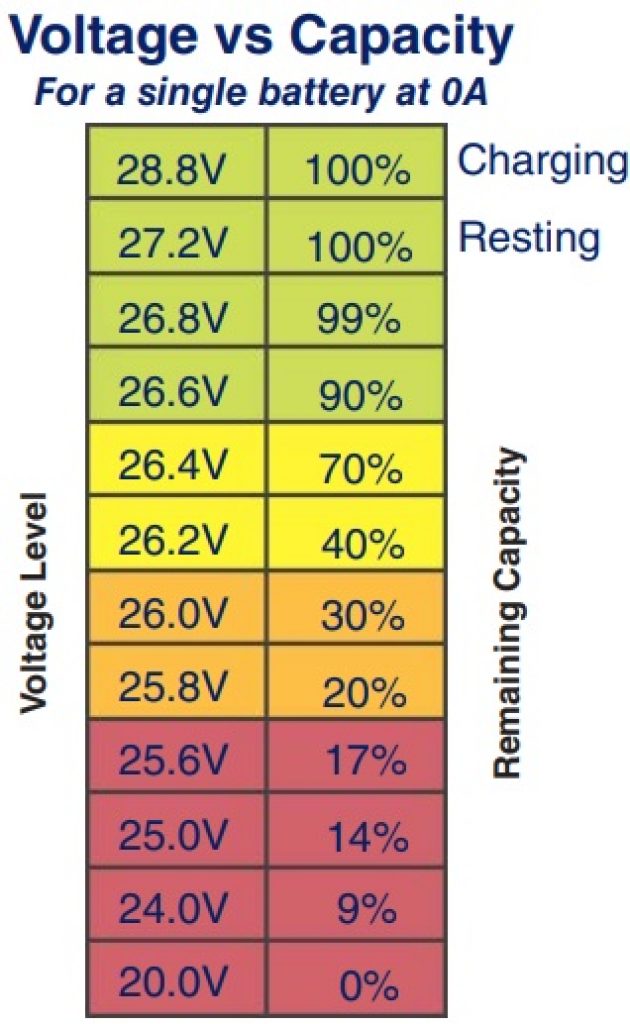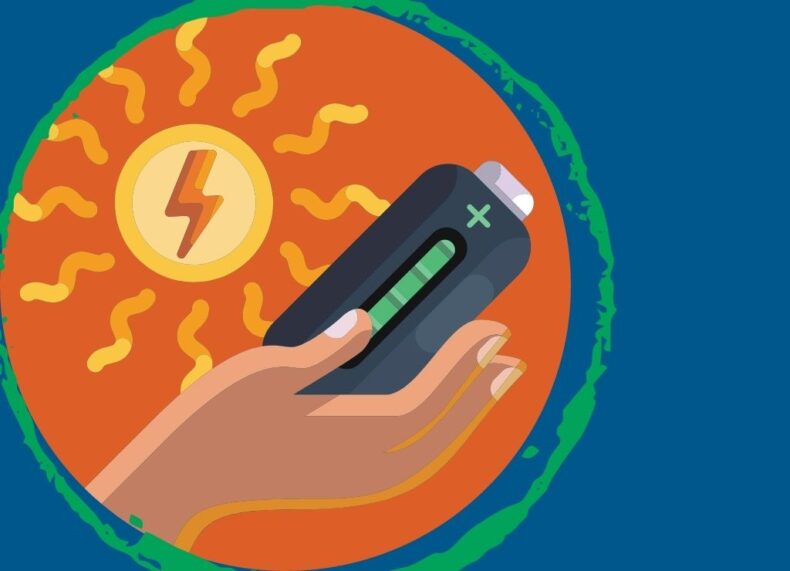Is your lithium battery damaged?
Lithium-ion batteries power our smartphones, laptops, and other devices, making them an essential part of our daily lives.
Thankfully the durability of lithium batteries is increasing. Nowadays, these batteries come with high-tech components like battery management systems (BMS), making them safer and more reliable than ever before.
But over time, even the best lithium batteries can suffer degradation or damage, leading to decreased performance or even safety risks. If you’re experiencing issues with your lithium battery, you may wonder if it’s damaged and needs replacing.
There are 5 warning signs that your lithium battery is damaged:
- The capacity is reduced.
- The voltage is low.
- The self-discharge rate is high.
- The battery is overheating.
- The battery is bloated.
This article will answer your most asked questions about damaged lithium batteries and how you can properly take care of your battery to extend its lifespan.
Table of Contents
How can you damage a lithium battery?
As of 2025, there are several types of batteries that exist for use in solar applications. The two most prominent lithium technologies are (lithium iron phosphate (LFP) and lithium-titanate (LTO). Both are robust and durable technologies.
The newest LiFePO4 batteries are certified to last 10 years and more than 5,000 cycles. In fact, The Tesla Powerwall+ and its alternatives are capable of exceeding 8,000+ cycles.
LTO batteries are even more durable, with up to 30,000 cycles (80% capacity retention) and 25 years of life.
Both LFP and LTO technologies include a BMS that regulates their charge/discharge cycles while equalizing and protecting the battery cells by monitoring the temperature and voltage.
The BMS can cut off each battery cell when it detects values above the fixed limits.
But despite their durability and BMS, several factors can damage your lithium battery:
External Environmental Factors
- Heat: temperatures higher than 140°F.
- Cold: for LiFePO4 batteries below -4°F.
- Water/air humidity.
- Physical damage (shock).
Internal Factors
- Overcharging above 16.5V for a 12V battery.
- Over-discharging below 10V for a 12V battery.
- Manufacturing defects.
- Low-quality components.
What happens if your lithium battery is damaged?
A damaged lithium battery can cause several events to occur. These events are categorized according to their risk state.
Low-risk events
- Low voltage.
- Low current.
- Lower capacity.
These events relate to the degradation of your battery’s performance, but they won’t pose a physical threat to your health. That said, they still require monitoring.
High-risk events
- Fire. or
- Explosion
- Leakage of the electrolyte (toxic and flammable)
Lithium is extremely reactive when in contact with water (even air humidity) and could catch fire. Overheating, overcharging, and shocks also promote thermal reactions inside the lithium battery.
What warning signs indicate that my lithium battery is damaged?
There are multiple warning signs that indicate your lithium battery is damaged. Some are quite alarming, while others only signify normal degradation over time.
The least alarming warning signs relate to your battery’s performance. The following conditions do not pose a safety risk:
- Low voltage.
- Reduced battery capacity.
- High self-discharge rate.

Source: PCMag (Tony Hoffman)
The most alarming warning signs relate to your lithium battery’s physical appearance. The following conditions do pose a significant safety risk:
- Overheating battery.
- Swollen battery.
- The battery has an unusual smell.
- The battery is discolored.
If you detect one of the most alarming signs, we strongly advise you to immediately disconnect the lithium battery and store it in a very well-vented area, far from other batteries and potential ignition sources.
Can you repair a damaged lithium battery?
First of all, let’s have a quick look at the major components of a lithium battery.
The latest lithium batteries consist of:
- Battery casing, usually ABS (Acrylonitrile Butadiene Styrene) plastic.
- Prismatic lithium battery cells.
- Battery management system (BMS).
- Connectors (bus bars, wires…).
All these components can be bought separately in specialized battery stores and also on Amazon. Therefore, this opens the possibility to DIY and repair your own lithium battery.
What to consider during lithium battery repairs
Repairing your lithium battery is possible, but please take extreme caution and follow these safety guidelines:
- First, suppose you detect one of the more alarming warning signs previously mentioned. In that case, you won’t be able to repair your lithium battery and must handle it with extreme caution. Our article on lithium battery recycling will show you what to do next.
- If you detect the least alarming warning signs, you can fix your lithium battery either at home or with the help of a battery specialist.
- The battery specialist will evaluate the degradation state of your lithium battery’s components, specifically the BMS and the prismatic lithium battery cells.
- They will measure the voltage and capacity of each prismatic cell by applying a power load and a charging current. If one or more cells are underperforming, they can be replaced.
- Then they will test the BMS. Most of the time, lithium battery failure is due to a defective BMS. The specialist will evaluate the BMS response to a power load and a charging current, along with its capacity to equalize multiple battery cells.
Note to our readers: It’s possible to replace a defective BMS. These components are widely available either in dedicated stores or on Amazon.
Can you reset a lithium battery?
If your lithium battery is stored for a long time or if it was over-discharged, the BMS might put it to sleep.
Now, if the battery voltage falls below 6V for a 12V battery and 12V for a 24V lithium battery, do not attempt to reset it. At a lower voltage, chemical reactions inside the battery cells could lead to internal short circuits.
On the other hand, most of the BMS will cut off the battery if the voltage falls below 8.8V (12V battery) and 17.6V (24V lithium battery).
In that case, you can rest or revive your lithium battery using a lithium battery charger’s “boost” function. You can find these on Amazon or through a battery recovery specialist.
Be sure to respect the polarity when connecting your lithium battery to the charger. Reverse polarity (+ plugged with -) can cause irreversible damage to your lithium battery.
Related reading: How do you charge a lithium battery with an alternator?
What voltage should a lithium battery be?
As previously mentioned, lithium batteries are made up of the association of multiple prismatic lithium battery cells connected in series. Therefore, the voltage of a lithium battery is the sum of the voltage of each lithium battery cell.
Note to our readers: The nominal voltage of a prismatic LiFePO4 battery cell is 3.2V: equivalent to 12.8V for a 12V lithium battery pack.
The lowest voltage is 2.5V: 10V for a 12V lithium battery and the highest voltage is 14.6V.
The figures below represent the battery voltage in the function of its capacity (all voltages are measured at zero loads).


During charging, apply the appropriate voltage for 12V and 24V LiFePO4 batteries, as summarized in the chart below.
| Charging parameters | 12V LiFePO4 battery | 24V LiFePO4 battery |
|---|---|---|
| Absorption voltage | 14.2V to 14.6V | 28.4V to 29.2V |
| Floating voltage | 13.4V to 13.8V | 26.8V to 27.6V |
Do lithium batteries become damaged if not in use?
Lithium batteries have rather low self-discharge rates — usually 2 to 3% per month. Therefore, you can store them safely for a prolonged period of time. However, you should follow the proper protocol.
Not using your lithium battery for months puts your battery at risk of over-discharge and permanent performance degradation.
There are two ways of properly storing your lithium battery:
- Some manufacturers recommend a 100% state of charge before storage.
- Other recommends a 40% state of charge.
In both cases, disconnect the battery cables. By doing so, you can ensure that no load is applied.
In addition, be sure to store them in a cool place (70°F is ideal).
5 Ways to look after your lithium battery
Usually, lithium batteries for solar systems or for solar generators are connected to a solar charge controller and to an inverter that converts DC power into AC. With the most advanced devices, you can even tune your lithium battery’s charging and discharging voltage.
Here are five ways to increase your lithium battery’s life:
1. Avoid temperatures below 32°F (0°C) and above 95°F (35°C)
Lithium batteries are electrochemical systems that store electricity as a chemical. Therefore, their performance is affected by ambient temperature. Operating your battery below 32°F(0°C) can cause metal deposition at the negative electrode, leading to a short circuit. Above 95°F(35°C), other parasitic reactions are promoted, leading to further degradation.
2. Do not charge to 100%
This sounds quite unnatural, but a high state of charge reduces your lithium battery’s life. Several experimental studies have shown that only charging your battery to 90% provides a lifespan that’s 2-5 times longer than fully charged batteries.
To do so, you have to reduce the float voltage by 0.1V to 0.3V compared to the indication of the manufacturer.
3. Do not discharge to 0%
You should also avoid draining your lithium battery completely. Deep discharge promotes metal degradation, leading to short circuits that can irreversibly damage your battery.
Usually, manufacturers recommend an 80% depth of discharge to extend your battery life. 70% depth of discharge can even double your battery life.
To adjust the depth of discharge, you need to modify the cut-off voltage of your BMS or your inverter.
- 24V battery, 80% DOD, Cut-off voltage=24V (with load)
- 12V battery, 80% DOD, Cut-off voltage=12V (with load)
4. Use partial-discharge cycles
Partial discharge cycles happen when less than 50% of the battery capacity is discharged before charging. This will extend your battery’s lifespan considerably. You can perform thousands of partial cycles before your battery starts to degrade.
One of the best partial-discharge cycles is from 75% to 25% capacity. The benefits of the partial discharge should be balanced by the lower available capacity (50%).
5. Do not charge/discharge them too fast
Even though lithium batteries are fit for quick charge with solar panels, high currents generate stress in the battery chemistry. The same happens with high discharging currents. Therefore, we recommend limiting continuous charge and discharge current to a maximum of 0.8C (80% of the battery capacity in 1 hour). For example, a 50Ah battery should be charged/discharged with max. current of 0.8*50= 40 Amps.
Final thoughts
We need durable solar batteries.
After a century of dominating markets, lead-acid batteries are now outdated compared to their lithium counterparts. Indeed, their life duration is only 3 years.
Lithium batteries, like LiFePO4, are much more durable and versatile. But their internal chemistry is still influenced by multiple factors, such as temperature and charging/discharging parameters.
The good news comes from a new lithium battery technology: LTO, slowly reaching the solar energy storage market.
LTO batteries are extremely robust against fast charging/discharging currents, tolerant to low/high temperatures, and durable with up to 30,000 cycles, making them a battery for life.

